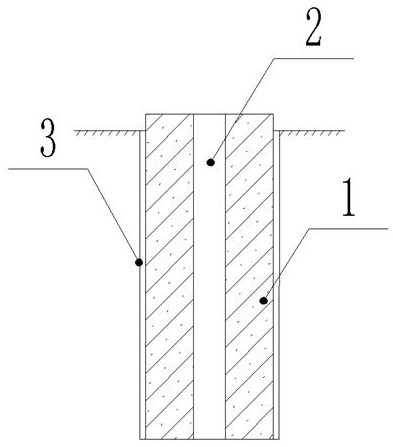A kind of utilization method of discarded bacteria stick
A technology for discarding bacteria and bacteria sticks, which is applied in fertilization methods, applications, fertilization devices, etc., can solve the problems of restricted nutrient supply capacity and poor soil fertilizer retention capacity.
- Summary
- Abstract
- Description
- Claims
- Application Information
AI Technical Summary
Problems solved by technology
Method used
Image
Examples
Embodiment 1
[0030] A method of utilizing waste bacteria sticks - fertilizer and water guide stick fertilization technology, including two parts:
[0031] 1) The production of fertilizer and water guide sticks, the remaining substances in the waste bacteria sticks have a high organic carbon content, and the rod-shaped waste bacteria sticks are drilled through the middle to form a carbon channel with a hollow inner hole with a diameter of 1.5-3cm in the middle. A tubular organic carbon rod with a high nitrogen ratio.
[0032] 2) Supporting use of technology, this technology is mainly applicable to orchards and other orchards in the rain-fed agricultural dryland areas along the Yellow River:
[0033] Step 1: Select 2-4 points under the outer canopy of the jujube tree in early and mid-October in autumn or mid-to-late spring in spring, and use a hole maker to make holes. Suitable, the general pit depth is 40cm, and the hole diameter is 13cm. In the next year, the punching position can be mov...
Embodiment 2
[0040] For flat orchards, especially for orchards that can be irrigated with a small amount of external water sources such as dry wells and river water, tree trays can be ridged or trenched under the canopy. The limited water is channeled deep into the soil, improving the orchard's ability to resist drought.
Embodiment 3
[0041] Embodiment 3, tree disc ridge + ground cloth covering:
[0042] For completely rain-fed agricultural areas or flat orchards without irrigation conditions, the tree trays can be ridged and covered with ground cloth to collect limited precipitation, and the fertilizer and water guide rods can be used to guide the limited rainwater into the ground below 40cm deep to reduce water evaporation and fully Use rainwater.
PUM
 Login to View More
Login to View More Abstract
Description
Claims
Application Information
 Login to View More
Login to View More - R&D
- Intellectual Property
- Life Sciences
- Materials
- Tech Scout
- Unparalleled Data Quality
- Higher Quality Content
- 60% Fewer Hallucinations
Browse by: Latest US Patents, China's latest patents, Technical Efficacy Thesaurus, Application Domain, Technology Topic, Popular Technical Reports.
© 2025 PatSnap. All rights reserved.Legal|Privacy policy|Modern Slavery Act Transparency Statement|Sitemap|About US| Contact US: help@patsnap.com

